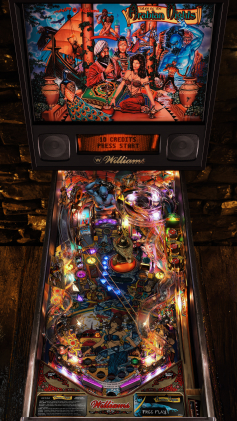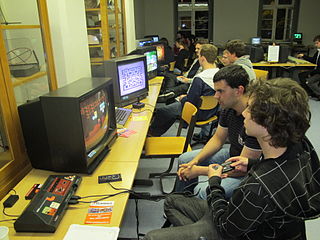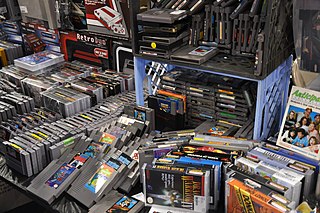
A video game console is an electronic device that outputs a video signal or image to display a video game that can be played with a game controller. These may be home consoles, which are generally placed in a permanent location connected to a television or other display devices and controlled with a separate game controller, or handheld consoles, which include their own display unit and controller functions built into the unit and which can be played anywhere. Hybrid consoles combine elements of both home and handheld consoles.

The Vectrex is a vector display-based home video game console - the only one ever designed and released for the home market, that was developed by Smith Engineering and manufactured and sold by General Consumer Electronics. It was first released for the North America market in November 1982 and then Europe and Japan in 1983. Originally produced by General Consumer Electronics, it was later licensed to Milton Bradley after they acquired the company. Bandai released the system in Japan.

UAE is a computer emulator which emulates the hardware of Commodore International's Amiga range of computers. Released under the GNU General Public License, UAE is free software.

MAME is a free and open-source emulator designed to recreate the hardware of arcade game systems in software on modern personal computers and other platforms. Its intention is to preserve gaming history by preventing vintage games from being lost or forgotten. It does this by emulating the inner workings of the emulated arcade machines; the ability to actually play the games is considered "a nice side effect". Joystiq has listed MAME as an application that every Windows and Mac gamer should have.

Visual Pinball ("VP") is a freeware and source available video game engine for pinball tables and similar games such as pachinko machines. It includes a table editor as well as the simulator itself, and runs on Microsoft Windows. It can be used with Visual PinMAME, an emulator for ROM images from real pinball machines.

ZSNES is a free software Super Nintendo Entertainment System emulator written mostly in x86 assembly with official ports for Linux, DOS, Windows, and unofficial ports for Xbox and macOS.

A ROM image, or ROM file, is a computer file which contains a copy of the data from a read-only memory chip, often from a video game cartridge, or used to contain a computer's firmware, or from an arcade game's main board. The term is frequently used in the context of emulation, whereby older games or firmware are copied to ROM files on modern computers and can, using a piece of software known as an emulator, be run on a different device than which they were designed for. ROM burners are used to copy ROM images to hardware, such as ROM cartridges, or ROM chips, for debugging and QA testing.

The Rockwell AIM-65 computer is a development computer introduced in 1978 based on the MOS Technology 6502 microprocessor. The AIM-65 is essentially an expanded KIM-1 computer. Available software included a line-oriented machine code monitor, BASIC interpreter, assembler, Pascal, PL/65, and Forth development system. Available hardware included a floppy disk controller and a backplane for expansion.

The Gravis UltraSound or GUS is a sound card for the IBM PC compatible system platform, made by Canada-based Advanced Gravis Computer Technology Ltd. It was very popular in the demoscene during the 1990s.
The CP System II or CPS-2 is an arcade system board that Capcom first used in 1993 for Super Street Fighter II. It was the successor to their previous CP System and Capcom Power System Changer arcade hardware and was succeeded by the CP System III hardware in 1996, of which the CPS-2 would outlive by over four years. The arcade system had new releases for it until the end of 2003, ending with Hyper Street Fighter II.

Nestopia UE - and its predecessor Nestopia - are an open-source NES/Famicom emulator designed to emulate the NES hardware as accurately as possible.
Homebrew, when applied to video games, refers to software produced by hobbyists for proprietary video game consoles which are not intended to be user-programmable. The official documentation is often only available to licensed developers, and these systems may use storage formats that make distribution difficult, such as ROM cartridges or encrypted CD-ROMs. Many consoles have hardware restrictions to prevent unauthorized development.

Retrogaming, also known as classic gaming and old school gaming, is the playing and collection of obsolete personal computers, consoles, and video games. Usually, retrogaming is based upon systems that are outmoded or discontinued, although ported retrogaming allows games to be played on modern hardware via ports or compilations. It is typically for nostalgia, preservation, or authenticity. A new game could be retro styled, such as an RPG with turn-based combat and pixel art in isometric camera perspective.

Minimig is an open source re-implementation of an Amiga 500 using a field-programmable gate array (FPGA).
MagiC is a third party and now open-sourced multitasking-capable TOS-compatible operating system for Atari computers, including some newer clone systems manufactured later. There are also variants that run as part of Mac and PC emulation environments, as well as on macOS Intel-Mac computers.

Higan is a free and open source emulator for multiple video game consoles, including the Super Nintendo Entertainment System. It was developed by Near. Originally called bsnes, the emulator is notable for attempting to emulate the original hardware as accurately as possible through low-level, cycle-accurate emulation and for the associated historical preservation efforts of the Super NES platform.

A video game console emulator is a type of emulator that allows a computing device to emulate a video game console's hardware and play its games on the emulating platform. More often than not, emulators carry additional features that surpass limitations of the original hardware, such as broader controller compatibility, timescale control, easier access to memory modifications, and unlocking of gameplay features. Emulators are also a useful tool in the development process of homebrew demos and the creation of new games for older, discontinued, or rare consoles.

In computing, an emulator is hardware or software that enables one computer system to behave like another computer system. An emulator typically enables the host system to run software or use peripheral devices designed for the guest system. Emulation refers to the ability of a computer program in an electronic device to emulate another program or device.

Video game preservation is a form of preservation applied to the video game industry that includes, but is not limited to, digital preservation. Such preservation efforts include archiving development source code and art assets, digital copies of video games, emulation of video game hardware, maintenance and preservation of specialized video game hardware such as arcade games and video game consoles, and digitization of print video game magazines and books prior to the Digital Revolution.















